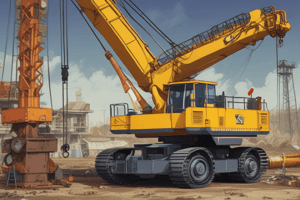Podcast
Questions and Answers
What must be done before operating a crane?
What must be done before operating a crane?
- Receive training and authorization (correct)
- Have another operator present
- Inspect the site conditions only
- Check only the fuel level
Which component should be inspected for proper working condition before crane operation?
Which component should be inspected for proper working condition before crane operation?
- The operator's personal safety gear
- The height of the crane
- The surrounding workplace aesthetics
- Control systems for proper operation (correct)
What is a key weather condition to monitor before operating a crane?
What is a key weather condition to monitor before operating a crane?
- Rainfall levels
- Temperature only
- Time of day
- Wind conditions (correct)
What should be done when refueling a crane?
What should be done when refueling a crane?
Why is it important to position cranes close to the load?
Why is it important to position cranes close to the load?
Which statement regarding rigging equipment is correct?
Which statement regarding rigging equipment is correct?
What is the recommended action if the crane comes into contact with energized power lines?
What is the recommended action if the crane comes into contact with energized power lines?
What should an operator continuously focus on to ensure safety?
What should an operator continuously focus on to ensure safety?
Flashcards are hidden until you start studying
Study Notes
Basic Safety Guidelines for Crane Operations
- Training and authorization are mandatory before operating cranes or any heavy equipment.
- Inspect cranes before use; ensure they are in proper working condition and report any doubts to a supervisor for inspection.
- Regularly maintain cranes as per manufacturer recommendations, addressing components showing wear or damage timely.
Inspection Protocol
- Conduct pre-operation inspections focusing on wire ropes, rigging components, and overall cleanliness to prevent accidents.
- Check essential fluids: fuel, oil, radiator water, and hydraulic levels to maintain crane functionality.
- Inspect control systems for proper operation; address any difficulties promptly.
- Maintain proper tire pressure and torque on wheels, especially when using outriggers.
Weather and Environmental Considerations
- Beware of poor weather conditions affecting crane stability and operations, such as wind or low visibility.
- In cold temperatures, allow oil to warm before applying load to prevent equipment damage.
Refueling and Electrical Safety
- Turn off all spark-producing devices before refueling and employ bonding and grounding methods with flammable liquids.
- Maintain awareness of nearby electrical lines. Stay 10 ft away from voltages up to 125,000 volts, 15 ft from 125,000-250,000 volts, and 25 ft from lines over 250,000 volts.
Emergency Procedures
- Know the location and use of emergency shutdown switches and procedures for safe operation.
- In case of contact with energized power lines, remain on the crane and avoid jumping off unless necessary, using a specific jumping technique to minimize shock risk.
Load Management
- Position cranes close to the load to limit swing and ensure a level setup for safe lifting operations.
- Count rigging equipment weight as part of the total load and always consult load charts to avoid overloading.
- Avoid fast movements while lifting to prevent machine damage and maintain safety.
Rigging and Communication
- Ensure all rigging equipment is correctly identified and secured before lifts; never ride on loads or allow personnel underneath raised loads.
- Use load indicators to verify weights and ensure clear communication with ground personnel during lifting operations.
Operator Responsibility
- Remain attentive and proactive to prevent accidents; be aware that negligence and shortcuts can lead to serious injuries.
- Acknowledge the complexity of crane capacities, which rely on numerous factors including loads, angles, and stability.
Conclusion
- Committed and knowledgeable crane operators, adhering to safety guidelines, significantly reduce risks associated with crane operations, promoting a safe workplace for everyone involved.
Basic Safety Guidelines for Crane Operations
- Mandatory training and authorization required for operating cranes and heavy equipment.
- Conduct pre-use inspections of cranes; report any issues to supervisors for further assessment.
- Perform regular maintenance following manufacturer guidelines to address wear and damage.
Inspection Protocol
- Execute pre-operation inspections focusing on wire ropes, rigging, and cleanliness to mitigate accidents.
- Check fluid levels: fuel, oil, radiator water, and hydraulic fluids to ensure proper crane functioning.
- Ensure control systems operate correctly and address any operational issues immediately.
- Maintain correct tire pressure and torque, particularly when employing outriggers.
Weather and Environmental Considerations
- Monitor weather conditions like wind and visibility that may compromise crane stability.
- In cold weather, allow oil to warm before loading to avoid damaging the equipment.
Refueling and Electrical Safety
- Switch off all spark-generating devices before refueling; use bonding and grounding methods for flammable liquids.
- Observe safe distances from electrical lines: 10 ft from up to 125,000 volts, 15 ft from 125,000-250,000 volts, and 25 ft from over 250,000 volts.
Emergency Procedures
- Familiarize yourself with the location and operation of emergency shutdown switches and procedures.
- If in contact with energized lines, remain on the crane; jump off only as a last resort, using a specific technique to minimize shock risk.
Load Management
- Position cranes as close to the load as possible to limit swing and ensure a level lifting setup.
- Include the weight of rigging equipment in total load calculations; refer to load charts to prevent overload.
- Avoid rapid lifting movements to protect equipment and maintain safety.
Rigging and Communication
- Properly secure and identify all rigging equipment before lifts; never allow personnel under raised loads or ride on loads.
- Utilize load indicators for weight verification and ensure clear communication with ground crew during operations.
Operator Responsibility
- Stay vigilant and proactive to avoid accidents; recognize that shortcuts lead to injuries.
- Understand the complexities of crane capacities, which depend on various factors like load size, angle, and stability.
Conclusion
- Knowledgeable crane operators who adhere to safety protocols significantly mitigate risks, fostering a safer workplace environment for all.
Studying That Suits You
Use AI to generate personalized quizzes and flashcards to suit your learning preferences.




